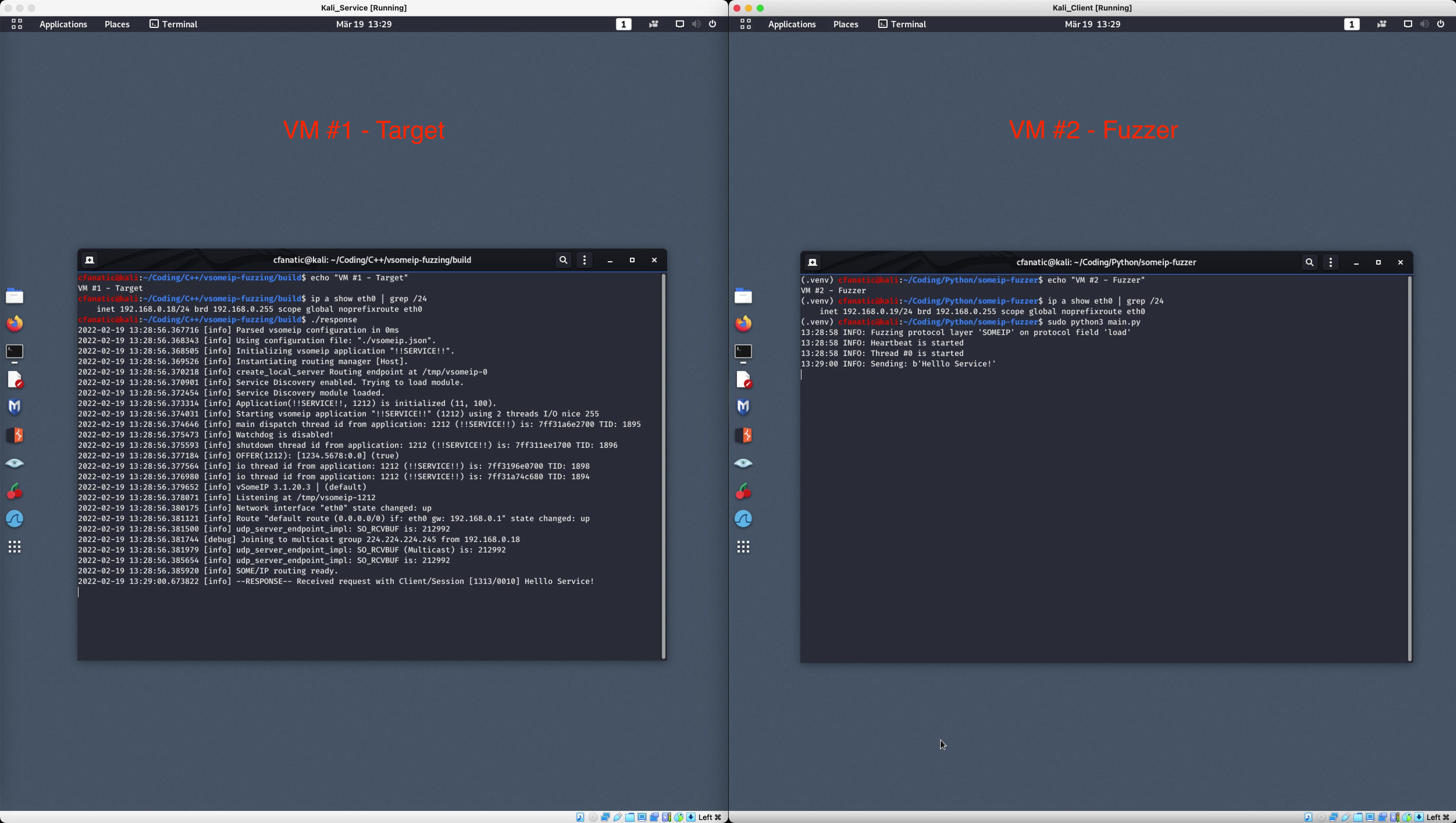This repository features a proof-of-concept for a SOME/IP network protocol fuzzer.
What it does is quite simple: It mutates user-defined protocol fields using radamsa.
Implemented is a heartbeat mechanism which checks whether the target service on the other end is still responding. If not, fuzzing will be terminated.
It is recommended to use two VMs which run any version of GNU/Linux each.
Furthermore, following software packages are required:
| VM #1 - Target | VM #2 - Fuzzer |
|---|---|
| CMake 3.16.3 | Python 3.7.6 |
| vsomeip 3.1.20 | scapy 2.4.5 |
| boost 1.65.1 | radamsa 0.6 |
The instructions below describe how to configure the VMs for the target service and protocol fuzzer. The default configuration assumes that 192.168.0.18 is the IP address on VM #1, and 192.168.0.19 on VM #2.
Clone vsomeip and vsomeip-fuzzing. Check out the branch feature-demo-someip, and follow the setup instructions. Call make response to build a SOME/IP service as the fuzzing target.
Adjust the IP address in the service configuration file accordingly.
When you run VSOMEIP_CONFIGURATION=../conf/vsomeip_response.json ./response, the output must show something similar to:
2022-02-18 14:59:28.396999 [info] Parsed vsomeip configuration in 0ms
2022-02-18 14:59:28.397593 [info] Using configuration file: "../conf/vsomeip_response.json".
2022-02-18 14:59:28.397751 [info] Initializing vsomeip application "!!SERVICE!!".
2022-02-18 14:59:28.398101 [info] Instantiating routing manager [Host].
2022-02-18 14:59:28.398342 [info] create_local_server Routing endpoint at /tmp/vsomeip-0
2022-02-18 14:59:28.398740 [info] Service Discovery enabled. Trying to load module.
2022-02-18 14:59:28.400098 [info] Service Discovery module loaded.
2022-02-18 14:59:28.400516 [info] Application(!!SERVICE!!, 1212) is initialized (11, 100).
2022-02-18 14:59:28.400694 [info] Starting vsomeip application "!!SERVICE!!" (1212)
2022-02-18 14:59:28.401511 [info] main dispatch thread id from application: 1212 (!!SERVICE!!)
2022-02-18 14:59:28.403643 [info] io thread id from application: 1212 (!!SERVICE!!)
2022-02-18 14:59:28.402029 [info] shutdown thread id from application: 1212 (!!SERVICE!!)
2022-02-18 14:59:28.402721 [info] Watchdog is disabled!
2022-02-18 14:59:28.404079 [info] vSomeIP 3.1.20.3 | (default)
2022-02-18 14:59:28.403850 [info] OFFER(1212): [1234.5678:0.0] (true)
2022-02-18 14:59:28.404343 [info] Network interface "eth0" state changed: up
2022-02-18 14:59:28.406458 [info] Route "default route (0.0.0.0/0) if: eth0 gw: 192.168.0.1"
2022-02-18 14:59:28.407549 [debug] Joining to multicast group 224.224.224.245 from 192.168.0.18
2022-02-18 14:59:28.407767 [info] udp_server_endpoint_impl: SO_RCVBUF (Multicast) is: 212992
2022-02-18 14:59:28.411331 [info] SOME/IP routing ready.
Clone someip-protocol-fuzzer, and run following instructions:
virtualenv -p python3 .venv
source .venv/bin/activate
pip3 install -r requirements.txt Open the fuzzer configuration file, and adjust the IP address configuration fields accordingly. Same for the source and destination ports. You can find this out by analyzing SOME/IP traffic using Wireshark.
Finally, install radamsa.
When you run sudo python3 main.py, the output must show something similar to:
15:13:15 INFO: Fuzzing protocol layer 'SOMEIP' on protocol field 'load'
15:13:15 INFO: Heartbeat is started
15:13:15 INFO: Thread #0 is started
15:13:16 INFO: Sending: b'Hell\\nSril\\nSril\\nService!ervice!ervice!ervice!'
15:13:17 INFO: Sending: b'o SService!'
15:13:18 ERROR: No heartbeat found on SOME/IP service
15:13:21 INFO: Heartbeat is stopped
15:13:21 INFO: Thread #0 is stopped
15:13:21 INFO: Exiting main()
Define which SOME/IP protocol field the fuzzer shall mutate. Open the protocol definition file, and set "fuzzer": "radamsa" for each field accordingly.
The example below fuzzes the payload of a paket using Hello Service! as the initial seed:
"load": {
"values": [
"48656c6c6f205365727669636521"
],
"type": "StrField",
"fuzzing": {
"fuzzer": "radamsa"
}
}The protocol definition export based on a given Wireshark trace was inspired by the presentation from Timo Ramsauer on Black-Box Live Protocol Fuzzing.
Execute the service on VM #1 and the fuzzer on VM #2 as described above.
Following process takes place, including a periodic heartbeat mechanism implemented as ping/pong exchange:
- The current state is a black-box approach. In order to improve the attack potential in grey-box fashion, one would need to implement a state machine to pass the most trivial checks on the target service first.
- It makes sense to call the heartbeat check after each input transmission. This way you can capture which particular mutated input is responsible for anomalies on the target service.

